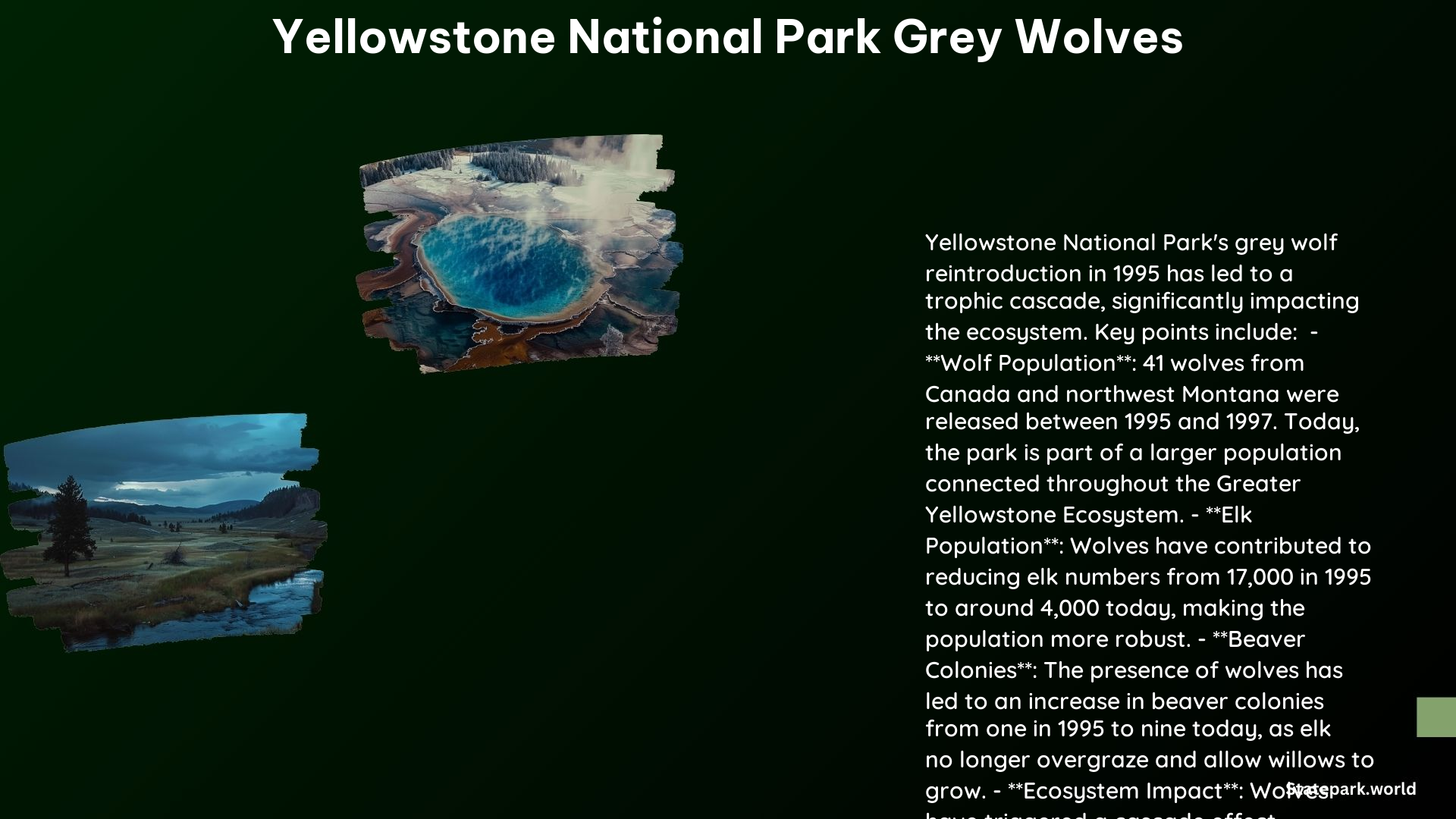Yellowstone National Park is home to a thriving population of grey wolves, which were reintroduced in 1995 after being absent from the ecosystem for nearly a century. The return of these apex predators has had a profound impact on the park’s delicate balance, triggering a cascade of changes that have transformed the landscape.
Timeline of Wolf Reintroduction
The journey of the grey wolves in Yellowstone National Park has been a long and fascinating one:
| Year | Event |
|---|---|
| 1872 | Yellowstone is created as the world’s first national park, with grey wolves present on the landscape. |
| 1884 | Montana institutes a wolf bounty, leading to the killing of many wolves. |
| 1914-1926 | Concerted efforts are made to exterminate wolves, with at least 136 killed in Yellowstone National Park. |
| 1940-1970s | Wolf pack sightings are rare, and it is believed that wolves are almost completely eradicated in the lower 48 states. |
| 1974 | The gray wolf is listed under the Endangered Species Act. |
| 1991 | Congress directs the U.S. Fish and Wildlife Service to prepare a draft Environmental Impact Statement on wolf recovery in Yellowstone and central Idaho. |
| 1994 | An Environmental Impact Statement is completed for the reintroduction of wolves into central Idaho and Yellowstone National Park. |
| January 1995 | Two shipments of wolves arrive in Yellowstone National Park from Canada, totaling 14 wolves. |
| March 1995 | The gates to the acclimation pens are opened, and the wolves are released into the park. |
| 2008-2017 | Wolves are delisted and relisted on the Endangered Species Act in Montana, Idaho, and Wyoming. As of April 26, 2017, gray wolves are delisted in Montana, Idaho, and Wyoming, indicating that they have sufficiently recovered. |
Impact on Vegetation

The reintroduction of wolves has had a profound impact on the vegetation within Yellowstone National Park. Here are some of the key changes:
Willow Stands
Before the wolves returned, elk populations were high, and they heavily browsed young willow, aspen, and cottonwood plants. With wolves present, elk are more vigilant and move into heavier timber, allowing willow stands to regenerate and thrive.
Beaver Colonies
The presence of wolves has triggered a cascade effect, leading to the growth of beaver colonies. Today, there are nine beaver colonies in the park, compared to just one before the wolf reintroduction.
Impact on Elk Population and Behavior
The wolf reintroduction has had a significant impact on the elk population and their behavior within Yellowstone National Park.
Elk Population
The wolf reintroduction has contributed to bringing elk numbers down from 17,000 in 1995 to around 4,000 today. This reduction has allowed for a more robust elk population.
Elk Behavior
Elk have become more vigilant and move into heavier timber when wolves are around. They also gather in smaller herd units, which helps to avoid encounters with wolves.
Other Impacts
The reintroduction of wolves has led to a trophic cascade, affecting various species in the ecosystem.
Trophic Cascade
The return of wolves has had a ripple effect, leading to an increase in grizzly bear numbers and the return of songbirds due to the regeneration of trees along rivers.
Economic Impact
The presence of wolves has also had a significant economic impact, with over 100,000 visitors coming to Yellowstone National Park in 2005 to see the wolves, generating $30 million for the local economy.
Current Status and Management
Wolf Population
As of December 2015, there were approximately 1,704 wolves and 95 breeding pairs in the Northern Rocky Mountain Distinct Population Segment.
Management
Wolves are managed by the appropriate state, tribal, or federal agencies, with no hunting allowed within Yellowstone National Park. Outside the park, Montana, Idaho, and Wyoming regulate and manage hunting.
Visitor Information
Safety
Wolves are not normally a danger to humans unless habituated by being fed. Visitors are advised to keep a safe distance and not feed wolves.
Viewing
Yellowstone National Park is recognized as one of the best places in the world to observe wolves in the wild.
References
- https://greateryellowstone.org/yellowstone-wolf-reintroduction
- https://www.yellowstonepark.com/things-to-do/wildlife/wolf-reintroduction-changes-ecosystem/
- https://education.nationalgeographic.org/resource/wolves-yellowstone/
- https://www.nps.gov/yell/learn/nature/wolves.htm
